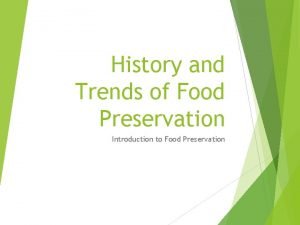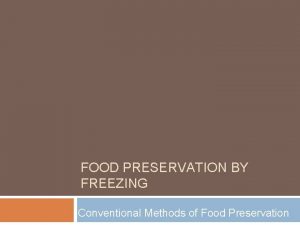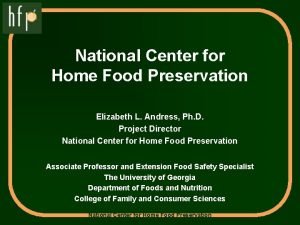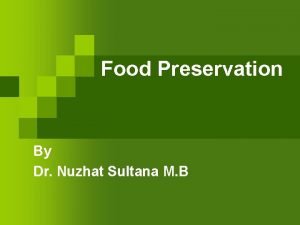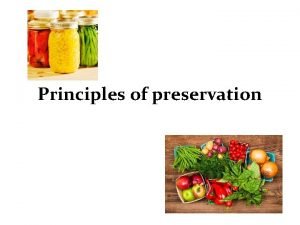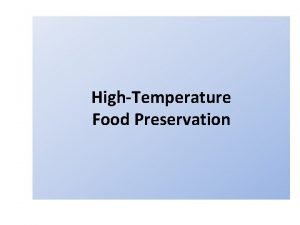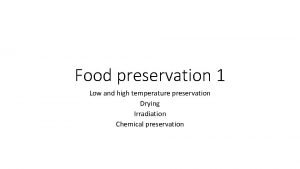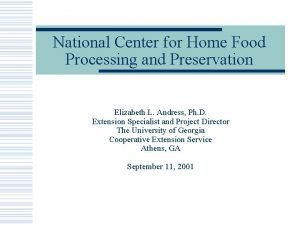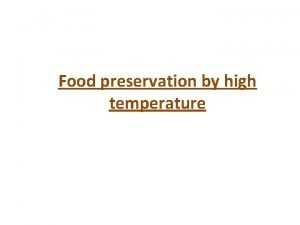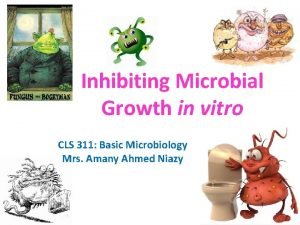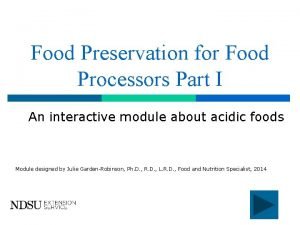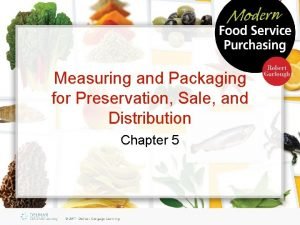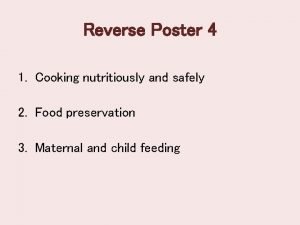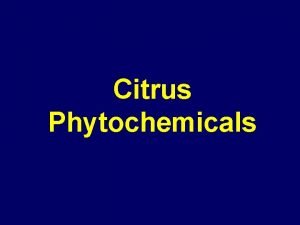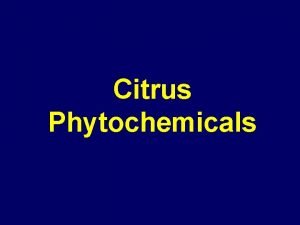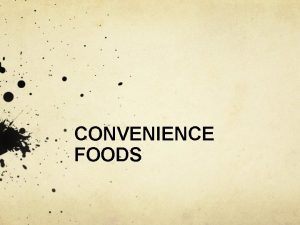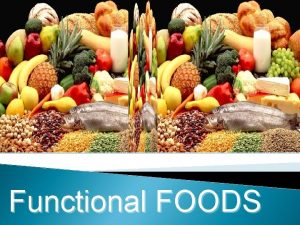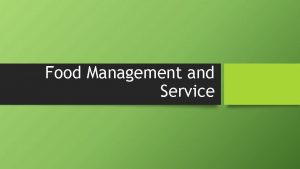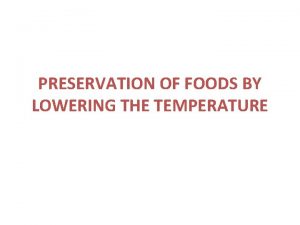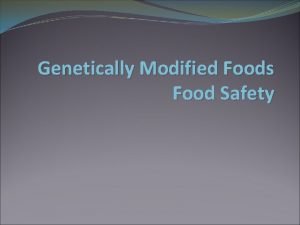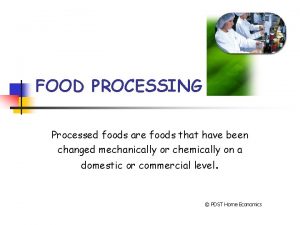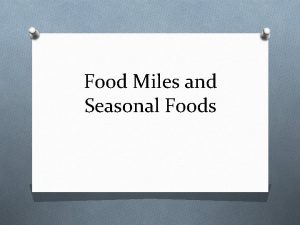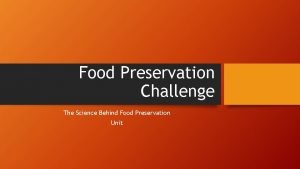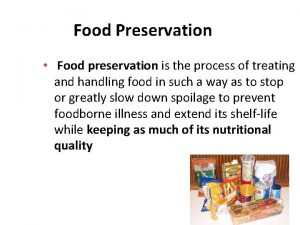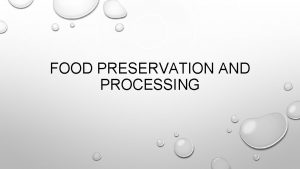Preservation of Foods What is food preservation Food















- Slides: 15

Preservation of Foods

What is food preservation? Food preservation involves the use of particular methods to make food last longer. There are both short - and long-term methods of preservation. Preservation extends the shelf life of food by killing the bacteria or slowing down the growth of bacteria.

Food preservation quiz

How does chilling preserve food? Chilling is a short-term method of preservation. Raw ingredients and food products need to be chilled. Chilling preserves food by slowing down the growth of bacteria.

How does freezing preserve food? Freezing is a long-term method of preservation. -18°C stops the growth of bacteria. Bacteria remain dormant until the food is defrosted. Quick freezing is needed so large ice crystals do not form and break the cell walls of the food. Freeze Drying involves freezing the food rapidly then removing ice from the food. This has less effect on taste than normal drying does.

What are the different methods of drying? Photograph by Walter Knirr, © South African Tourism Traditional methods of removing moisture are by sun drying: tomatoes, dates, figs, chillis, peppers and sultanas are dried in this way. This method needs heat and some wind to dry out the food before spoilage happens. Modern methods of removing moisture include spray drying. Liquids are spray-dried in a funnelshaped chamber; solid foods are dried in a continuous tunnel; more delicate foods are dried in a fixed cabinet.

Modified atmosphere packaging (MAP) is used to extend the shelf life of bacon, cheese, crisps, salad, fruit. . It slows bacterial growth by modifying the air that surrounds the food. The air is flushed out and replaced with gases such as oxygen or nitrogen before the pack is sealed.

How do high temperatures preserve food? High temperatures stop bacterial growth by killing the bacteria. Heat processing is used for preserving all sorts of foods and food products. Preservation of Milk Pasteurization 72°C for 15 seconds Sterilization 110 to 120°C for 10 – 30 minutes UHT 130°C and 150°C for 1 -3 seconds. Using heat then removal of air to preserve foods Canning and bottling involve sterilizing food to kill bacteria and packing in airtight containers to prevent recontamination.

What chemicals are used for preserving? salt Salt is used for preserving fish and meat. It absorbs the water from the food, taking away the moisture which bacteria need to grow. It also creates a strong osmotic pressure. Smoking is used for fish and meat. The chemicals from the smoke and heat help destroy bacteria. smoking sugar Vinegar is acidic and used in preserving pickles, chutneys and vegetables. vinegar Sugar is used in jam and chutney. Sugar absorbs the moisture by osmosis, so bacteria cannot grow. Boiling jam and chutney also kills bacteria.

Irradiation of Food Irradiation can be used to kill bacteria that cause food poisoning, such as salmonella, campylobacter and E. Coli. It also helps to preserve food and reduce food waste. During irradiation, food is exposed to electron beams, X-rays or gamma rays. Some consumers are concerned that we don’t know enough about the possible long term health effects of irradiation

Method Canning Bottling Freezing How its done Food treated Other info this way Method How its done Food treated Other info this way Canning Bottling Freezing Drying Irradiatio n Jam Salting Pickling Smoking Jam Salting Pickling Smoking

Method How its done Food treated this way Other info Canning High temperatures kill Bottling bacteria. Container is Freezing -18 deg. C is used – The water turns to ice, so bacteria cannot get any moisture. sealed to keep air and bacteria out. bacteria cannot survive at this low temperature. Drying Irradiation Energy waves are Jam Salting passed through the food to kill the bacteria. Pickling Method How its done Food Other info treated this way Canning High temperatures kill Bottling bacteria. Container is Freezing -18 deg. C is used – The water turns to ice, so bacteria cannot get any moisture. sealed to keep air and bacteria out. bacteria cannot survive at this low temperature. Rice, Pasta, Milk powder, coffee Drying Herbs, spices Irradiation Energy waves are passed Herbs, spices Rice, Pasta, Milk powder, coffee through the food to kill the bacteria. Pectin in fruit makes jam set. Bacon, tuna Brine is salt in brine. water. Smoking Chemicals in the smoke prevent growth of micro-organisms. Some food is cooked when it is smoked Jam Salting Bacon, tuna Brine is salt in brine. water. Pickling Pectin in fruit makes jam set. Smoking Chemicals in the smoke prevent growth of micro -organisms. Some food is cooked when it is smoked

Reduce temperature Canning Bottling Freezing Drying Irradiation Jam Salting Pickling Smoking Place the methods in the correct part of the VENN diagram to show what has happened to them.


Freezing: Freeze foods to slow growth/make organisms dormant. Most products can be preserved in a freezer kept at the correct temperature e. g. frozen fish, meat products, ready meals, fruit and vegetables. Shelf lives vary according to product type. Use by dates identify shelf life. Chilling: Keeping food in the fridge or a chiller cabinet slows down growth of microorganisms. A wide range of products can be preserved in a refrigerator e. g. margarine, salad dressings, salad ingredients. Shelf lives vary according to product type. Use by dates identify shelf life. Drying: removes the moisture which stops bacterial growth e. g. herbs, packet sauces. Drying: Curing: removes the moisture which stops bacterial growth e. g. meats. Jam Making/Jelly Making/Marmalade: provides a sugary medium which inhibits growth of bacteria and mould e. g. blackcurrants, gooseberries. Heat also plays a part. Shelf life varies depending on storage. Pickling: alters the p. H levels inhibiting growth of bacteria and moulds e. g. onions, cabbage, and hard boiled eggs. Shelf life varies between products. Bottling/chutneys: Acidity is crucial in chutneys and some bottled foods because it prevents the growth of the bacteria Clostridium botulinium. Acidity level of the products used can be adjusted by adding lemon juice, citric acid or vinegar. Fruits may be bottled in sugar solutions e. g. gooseberries, cherries. Heat also plays a part in destroying bacteria. Salting: the salt draws moisture from the food which therefore prevents/inhibits growth of bacteria and moulds e. g. fish. Smoking: Dries the food, removing some moisture and thus inhibits growth of bacteria. e. g. smoked fish, meats. Canning: food contents are processed and sealed in an airtight container. Canning provides a shelf life typically ranging from one to five years, although under specific circumstances it can be much longer. Vacuum Packing: Removes air so no bacteria/moulds can grow e. g. cheese, bacon. Irradiation: is the exposure of food to ionizing radiation. (high-energy electrons and gamma rays) The treatment has a range of effects, including killing bacteria, molds, insect pests, reducing the ripening and spoiling of fruits, and at higher doses inducing sterility. e. g. strawberries.
 Food preservation history
Food preservation history Hurdle technology
Hurdle technology Methods of food freezing
Methods of food freezing National center for home preservation
National center for home preservation Nuzhat sultana
Nuzhat sultana Principle of preservation
Principle of preservation Burying meat in the ground
Burying meat in the ground High temperature in food preservation
High temperature in food preservation High temperature food preservation
High temperature food preservation Microwave food preservation
Microwave food preservation National center for home food preservation
National center for home food preservation High temperature food
High temperature food Physical method of food preservation
Physical method of food preservation Food preservation definition
Food preservation definition Advantages of food preservation
Advantages of food preservation Food preservation poster
Food preservation poster
